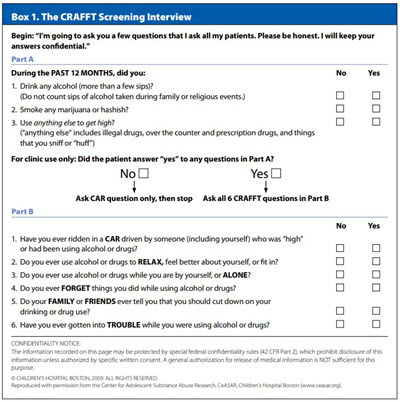Example Substance Use Screening and Assessment Tool(s)
Following are the Screening to Brief Intervention (S2BI) and Car, Relax, Alone, Forget, Friends, Trouble (CRAFFT) screening tools with scoring interpretations:
TABLE 3 S2BI Screen for Substance Use Risk Level
|
The following questions will ask about your use, if any, of alcohol, tobacco, and other drugs. Please answer every question by clicking on the box next to your choice.
|
|
___________________________________________________________________________
In the past year, how many times have you used …
|
|
Tobacco?
|
|
-Never
|
|
-Once or twice
|
|
-Monthly
|
|
-Weekly or more
|
|
Alcohol?
|
|
-Never
|
|
-Once or twice
|
|
-Monthly
|
|
-Weekly or more
|
|
Marijuana?
|
|
-Never
|
|
-Once or twice
|
|
-Monthly
|
|
-Weekly or more
|
|
STOP if answers to all previous questions are “never.” Otherwise, continue with the following questions.
|
|
In the past year, how many times have you used…
|
|
Prescription drugs that were not prescribed for you (such as pain medication or Adderall)?
|
|
-Never
|
|
-Once or twice
|
|
-Monthly
|
|
-Weekly or more
|
|
Illegal drugs (such as cocaine or Ecstasy)?
|
|
-Never
|
|
-Once or twice
|
|
-Monthly
|
|
-Weekly or more
|
|
Inhalants (such as nitrous oxide)?
|
|
-Never
|
|
-Once or twice
|
|
-Monthly
|
|
-Weekly or more
|
|
Herbs or synthetic drugs (such as salvia, "K2," or bath salts)?
|
|
-Never
|
|
-Once or twice
|
|
-Monthly
|
|
-Weekly or more
___________________________________________________________________________
|
Source: Levy SH, Williams JF; Committee on Substance Use and Prevention. Substance use screening, brief intervention, and referral to treatment. Pediatrics. 2016;138(1):e20161211. Available at: https://doi.org/10.1542/peds.2016-1211. Accessed August 29, 2019
|
S2BI Interpretation
|
|
Score
|
Substance Use Disorder (SUD)
|
BI Goals
|
|
No use of any substance
|
None
|
Positive reinforcement and encouragement to delay initiation.
|
|
Once or twice use of any substance
|
None
|
Brief advice to encourage cessation.
|
|
Monthly use of any substance
|
Mild-moderate SUD
|
Brief motivational intervention to encourage cessation or reduce use.
|
|
Weekly or greater use of any substance
|
Severe SUD
|
Brief motivational intervention to reduce use or risk behaviors AND accept referral to treatment.
Adolescents with nicotine, alcohol, or opioid addiction may also benefit from medications.
|
Source: Levy S, Weiss R, Sherritt L, et al. An electronic screen for triaging adolescent substance use by risk levels. JAMA Pediatr. 2014;168(9):822–828
The CRAFFT screening tool asks a series of 6 questions to screen adolescents for high-risk alcohol and other drug use disorders simultaneously. It begins with 3 opening questions, which should be asked as written.
During the past 12 months, did you:
1. Drink any alcohol (more than a few sips)?
2. Smoke any marijuana or hashish?
3. Use anything else to get high?
Using the tool as an assessment to explore “yes” responses and to reveal the extent of the patient’s substance use-related problems may be more effective for gathering details for use in Screening, Brief Intervention, Referral to Treatment (SBIRT) intervention. If Yes is answered in Part A, it is necessary to ask questions to determine the frequency of substance use and to ask all 6 questions in Part B.
Following are the CRAFFT tool and scoring interpretation:

Source: Knight J, Roberts T, Gabrielli, Hook SV. Adolescent alcohol and substance use and abuse. In: Performing Preventative Services: A Bright Futures Handbook. Elk Grove Village, IL: American Academy of Pediatrics; 2017:3
CRAFFT Interpretation
|
Stage
|
Description
|
BI Goals
|
|
Abstinence
|
The time before an individual has ever used drugs or alcohol more than a few sips
|
Provide positive reinforcement and education for making a healthy choice.
|
|
Substance use without a disorder
|
Limited use, generally in social situations, without related problems. Typically, use occurs at predictable times, such as on weekends.
|
Provide counseling regarding medical harms of substance use and advise to stop.
|
|
Mild to moderate substance use disorder (SUD)
|
Use in high-risk situations, such as when driving or with strangers. Use associated with a problem, such as a fight, arrest, or school suspension. Use for emotional regulation, such as to relieve stress or depression. Defined as meeting 2 to 5 of the 11 criteria for an SUD in the DSM-5.
|
Explore patient-perceived problems with use. Provide counseling regarding medical harms of substance use. Negotiate a behavior change to quit or reduce. Set up a follow-up date to reassess and check progress. Consider the need to break confidentiality if there is a risk of harm or other immediate attention is warranted.
|
|
Severe SUD
|
Loss of control or compulsive drug use associated with neurologic changes in the reward system of the brain. Defined as meeting >6 of the 11 criteria for an SUD in the DSM-5.
|
Refer to the appropriate level of care, involving parents in treatment planning if possible. Follow up to ensure compliance. Confidentiality may need to be broken; consider negotiating how this will happen.
|
Note: When using the CRAFFT tool, it is recommended that the provider also asks additional questions during the clinical interview to determine the patient’s frequency of substance use.